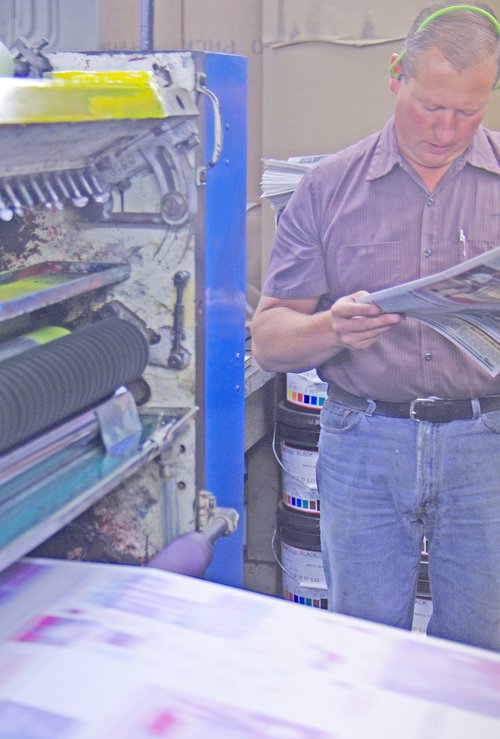The people who work at the newspapers of southwest Wisconsin are in mourning as one our longtime colleagues, Head Pressman Phil Muench, passed away the afternoon of Dec. 10 after an extended fight with the COVID-19 virus.
If you have read almost any southwest Wisconsin newspaper for any period of time, or if you get The Reminder or Round-Up shoppers at your home, you have gotten a product that Phil Muench had a hand in.
Actually, both of his hands. Phil Muench has been part of this organization since May 1988, when he started just a few years out of high school. Phil started working with Clarence “Zippy” Reuter and Claude Rice, two longtime printers who were coming close to the end of their careers.
They infused Phil with their decades of knowledge, as well as their dedication to the craft, and it was not long before Phil was made head pressman.
He relished the responsibility, and was invested in the job, going to many workshops and conferences with his boss Bill Hale. Phil never lost the drive to make things better, to putting out the best product possible.That led to Phil overseeing additions of printing units to the original 1972 four-unit Harris press that was in Lancaster when he started. Phil added three units to the original press that allowed CMYK printing regularly.
Phil moved the newspaper towards the 21st century, doing the research and installing a digital imagesetter in January 2004, which printed negatives of the pages directly, as opposed to taking a photograph of the pages and processing large negatives.
Five years later, Phil tracked down equipment for a CTP (Computer to Plate) system, eliminating the negative completely and burning the pages directly onto the plates that go on the press. Phil saved the company a bunch of money, finding the unit for one-third the price.
“None of that would have happened without Phil’s awareness and leadership,” Publisher John Ingebritsen said.

All of this progress was done while Phil maintained the weekly operations in Lancaster, where more than 40,000 copies of a dozen different publications are printed, stuffed inserts, printed mailing labels, and processed to be placed in the mail or delivered to newsstands across the region. He made sure we had delivery drivers, he knew when the press needed attention, he hired the inserting team, he had a handle on pricing for parts and he always looked for the best deals.
No little detail would be overlooked by Phil, and despite all this advancement of technology, Phil showed that operating a press is still really a craft. A press is not like a printer - there is constant adjustment going on. Newspapers utilize a CMYK process, which uses a mix of cyan, magenta, yellow, and black inks to create colors. Printers like Phil have to line up eight spinning cylinders to make sure a clean, sharp image is printed.
All that color is being run through spouts that drop it onto those cylinders, and they are adjusted by hand - too much magenta and a face will be red, not enough and the person could look green.
This is done again and again, as each publication is different, with different colors all over the page….and each run changes as the press warms up and runs for a length of time - adjustments for the first 1,000 are different then at 10,000.
Phil knew those Harris presses like a mechanic knows a classic car, and he could understand what it was doing by its sound and its production. He could tell when the blankets that go between the plates and the cylinders were worn, and could change out a press motor in very little time. Phil had a confidence in his craft, and we all trusted him.
In 2017, Phil and pressmen Earl McLean and Shawn Sisley took on the herculean task of changing out cylinders in one of the press towers. It was corroded and warped, but taking the unit out meant the entire press would be down, and any delay meant we would have to print elsewhere. Things did not go quite to plan, but Phil never panicked - he got additional parts in and still got things done for testing in the timeframe that still allowed us to print the next editions on time. They did it again a year and a half later on another unit of the press.
He was invested not only in his job, he was invested in his life from his wife to his children to his family at work and his many friends. He loved his time on the river in the summer and was especially active this past summer. He had a great smile and a hearty laugh and he always talked about food.
Being able to tackle difficult tasks made us believe he could win his fight against COVID. During his six-week fight with COVID, so many people asked about him regularly. It was a testament to who he was as a person. There is no replacing Phil and the experience he brought to our operation. Even more so, there is no replacing the light and energy he brought to our lives.
We will miss him more than all the words we have ever put onto newsprint.






